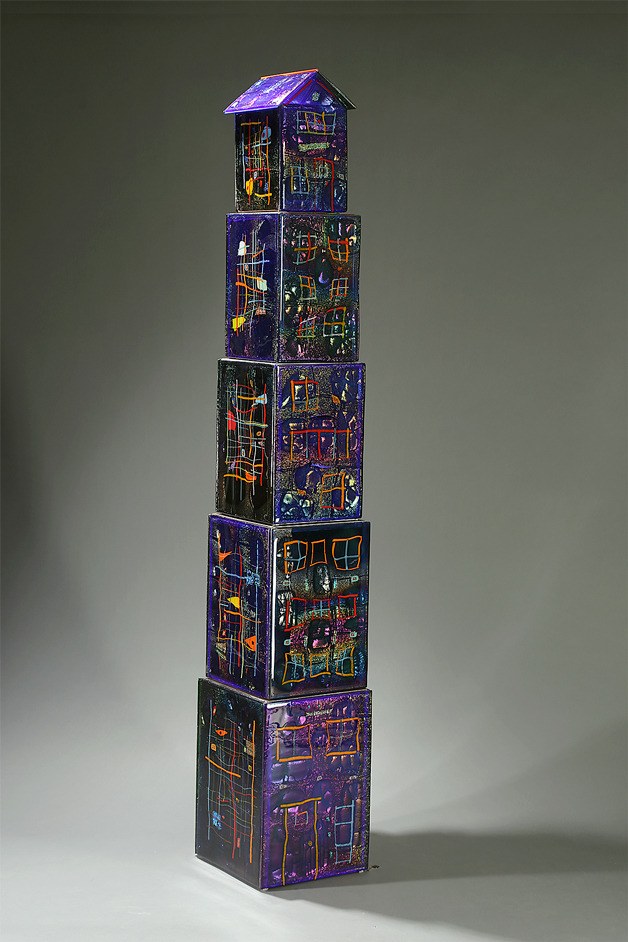A new year will bring with it color, shape and light in the form of new sculptures to stand tall at Langley’s Second Street plaza.
For the second time since late 2014, the city will install new sculptures to its de facto town center. Installation is planned for Jan. 7 with an official unveiling at 1 p.m. Saturday, Jan. 9 on Second Street between Anthes and Cascade avenues.
The men behind the pieces are Dale Reiger of Greenbank and Woody Morris of Clinton. Both are career artists who pursue other creative endeavors — Reiger builds homes and Morris runs a water feature company. They replace Lloyd Whannell’s and Sue Taves’ sculptures, which were first installed in October 2014. All four have space at the Freeland Art Studios.
The new sculptures from Reiger and Morris were picked by the Langley Arts Commission, a citizen board responsible, among other tasks, for selecting the sculptures on an annual basis. Each artist will receive a $600 stipend for displaying their work which will be viewed by thousands of Langley visitors over the next 12 months. 
“We selected these two pieces because they were very creative and different than any art we’ve had in a long time,” said Frank Rose, the arts commission chairman. “They were impressive in their presence and size and color.”
“This will be a nice mixture of art there on the plaza,” he added.
Reiger’s towering sculpture will stand more than 9 feet tall. Made of about 22 pounds of fused and cast glass, supported by almost 300 pounds of steel, “Observation Tower” is a splash of red, orange, green, blue, yellow and purple in five stacked boxes.
“This is the biggest piece of glass or sculpture I’ve made,” Reiger said while taking a break from work inside his Greenbank studio. 
It is also Reiger’s first time being exhibited in a public space, despite having his glass works in California and Washington galleries.
Inspiration for the tower came from a small island in Japan. Naoshima, Japan, became famous for its eclectic architecture, art collections and installations. He and his wife visited in 2014, and Reiger recalled walking into a house filled with glass and light, an experience he has since worked to recreate with his art.
“I thought, ‘I want to make that,’ ” Reiger said, adding that he wants to “make a glass house that you can walk into.”
Putting his work on display for $600 is more about the exposure than the immediate financial gain. Reiger said having the chance to be viewed by thousands is a mutually beneficial relationship between Whidbey Island artists, Langley and, he one day hopes, the entire county.
“Your work is seen by other people, and the other part is it is a contribution to Langley,” he said. “Art is welcoming … it contributes to the attraction of the city. Langley has been successful in that venue.”
When the Langley Arts Commission was launched in 2014, its first task was to select sculptures for the plaza. Money from the Second Street redesign project was to be set aside for the commission to decide on how to best implement a public art plan. With limited funds, purchasing sculptures was eliminated as an option and was replaced with the idea of leasing artworks for a year and rotating them.
In its first year, the city made a bit of money with the prompt sale of Taves’ sculpture “Waves.” It sold within the first week and Langley got a 20 percent commission.
Having not used the entire $20,000 budget initially set aside for the Second Street sculpture plaza, the arts commission was able to divert funds to other projects around town. A sculpture will be installed in front of the post office just up the road on Second Street, and other areas on Clyde Alley from Third to Second Street and at Seawall Park are being planned and developed as sculpture parks.
Combined with a private sculpture park on Camano Island and another private park in Freeland, Reiger said his and others’ consistent presence in Langley could help cement Whidbey Island and the city’s place in the arts world.
“Whidbey could become more of a destination for sculptures than any island in the United States,” he said.


